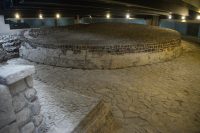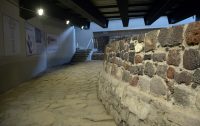 The 14th century temple to the wind god Ehécatl-Quetzalcóatl discovered underneath a former supermarket in Mexico City has opened to the public. The temple was found in 2014 after the old El Sardinero supermarket in the Tlatelolco neighborhood was demolished giving archaeologists from the National Institute of Anthropology and History (INAH) a rare opportunity to excavate under the crowded streets of Mexico City. This site is on a heavily trafficked avenue. It has a busy shopping center, the Plaza Tlatelolco, on one side and a massive housing unit on the other. There was no way of breaking ground if it hadn’t been for the demise of the supermarket building.
The 14th century temple to the wind god Ehécatl-Quetzalcóatl discovered underneath a former supermarket in Mexico City has opened to the public. The temple was found in 2014 after the old El Sardinero supermarket in the Tlatelolco neighborhood was demolished giving archaeologists from the National Institute of Anthropology and History (INAH) a rare opportunity to excavate under the crowded streets of Mexico City. This site is on a heavily trafficked avenue. It has a busy shopping center, the Plaza Tlatelolco, on one side and a massive housing unit on the other. There was no way of breaking ground if it hadn’t been for the demise of the supermarket building.
Less than 10 feet under the surface, the 2014 excavation unearthed the top of a circular stone platform and the burials of 20 people and animals. A follow-up excavation in 2016 revealed the full platform, an impressive 36 feet in diameter and four feet in height with a 13-foot access platform in the front. Much of it was still covered with its original stucco, a very rare surviving feature. The second dig also found another eight human burials.
In total, the remains of 32 individuals were discovered at the site, including children and adolescents who are believed to have been sacrificed to Ehécatl-Quetzalcóatl. Ehécatl was the rain-bringer and according to early Spanish chroniclers, the amount of rain that fell was determined by the number of tears shed by the sacrificial victims.
The excavated ceremonial enclosure, almost 4,000 square feet in area, has been preserved in situ as a subterranean archaeological park. It can be accessed through the Plaza Tlatelolco shopping center on Ricardo Flores Magón Avenue. You can’t just walk in, however. Due to the limited space in the enclosure and to maintain a propitious environment, visits to the temple are by appointment only.
 The underground archaeological site is the product of collaboration between property owners, the construction company and the government which by law owns all archaeological remains discovered in Mexico. In the past, Mexico City’s explosive development has come at the expense of its pre-Hispanic cultural patrimony, much of which was built over without concern for preservation. Thanks to the hard work of archaeologists and advocates, priorities have shifted over the past two decades, and the new temple site is being held up by INAH as an example of how development doesn’t have to come at the expense of archaeology and can in fact benefit from it. The shopping center will get more traffic, prestige from its underground treasure while the city’s archaeological heritage is preserved.
The underground archaeological site is the product of collaboration between property owners, the construction company and the government which by law owns all archaeological remains discovered in Mexico. In the past, Mexico City’s explosive development has come at the expense of its pre-Hispanic cultural patrimony, much of which was built over without concern for preservation. Thanks to the hard work of archaeologists and advocates, priorities have shifted over the past two decades, and the new temple site is being held up by INAH as an example of how development doesn’t have to come at the expense of archaeology and can in fact benefit from it. The shopping center will get more traffic, prestige from its underground treasure while the city’s archaeological heritage is preserved.